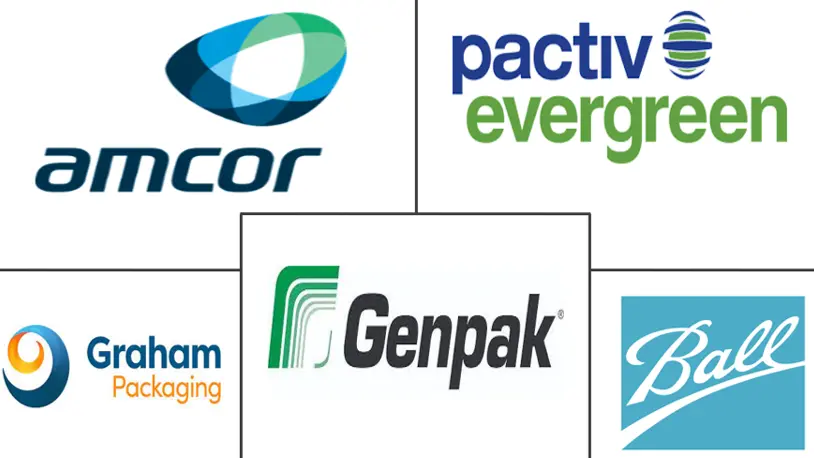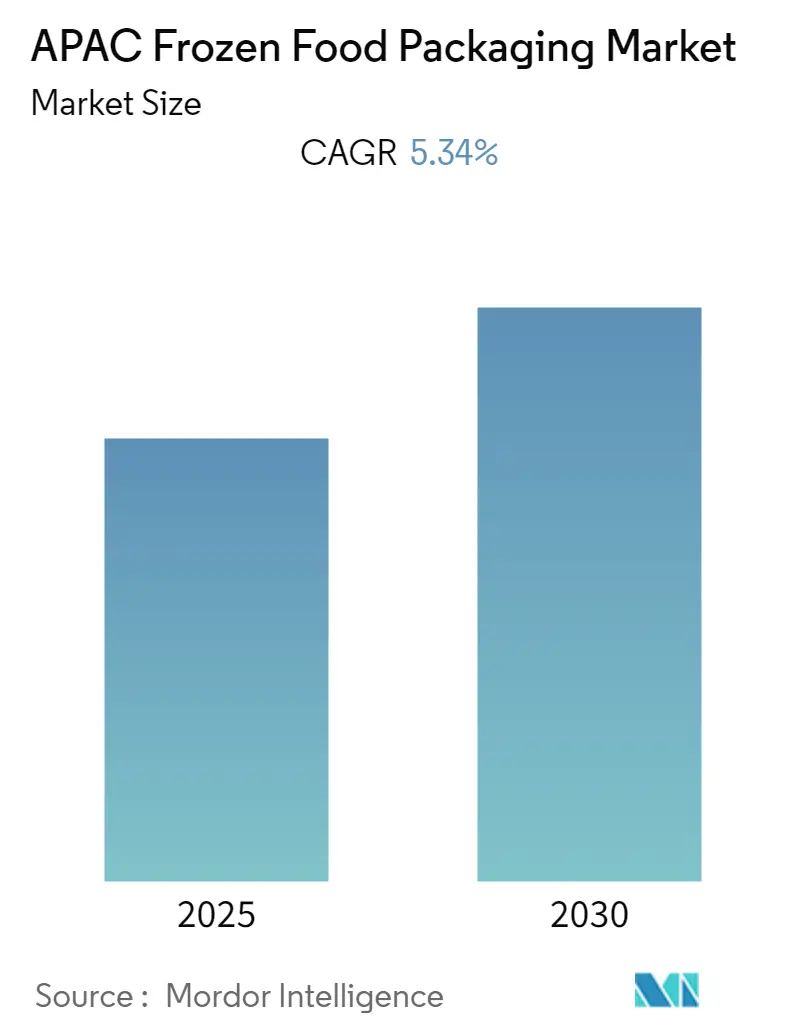
APAC Frozen Food Packaging Market Analysis by Mordor Intelligence
The APAC Frozen Food Packaging Market is expected to register a CAGR of 5.34% during the forecast period.
- The growing population in the Asia Pacific region is propelling the demand for food and frozen food products. Surging urbanization and expanding awareness about foodborne illnesses, food wastage, spoilage, quality products, and fast-paced lifestyle have shifted the preferences of consumers towards frozen food products, which requires less time for cooking than the traditional home-cooked meal.
- "On-the-go" customer base and rising purchasing power have further fueled the market through the growth in developing nations like China and India. The demand for frozen food packaging is also predicted to grow as there is a rising need for appealing, inventive, and easy-to-carry packaging to set the product apart from the competition.
- China has the largest share of the Asia-Pacific frozen food packaging market. According to the National Bureau of Statistics of China, 64.72% of the population resided in cities in 2021, contributing to the increased demand for frozen food products. Chinese consumers are now looking for easy-to-use and quality food products. The need for frozen meat and other regularly consumed products in the fixed food market has been constant in the region because of their availability.
- Players in the region are teaming up with private equity companies to expand their footprint in one of the nations with the highest rate of QSR development due to the rising ice cream consumption. It will spur demand for frozen food packaging. For instance, in May 2022, Dairy Queen, the prominent quick-service ice cream and fast food restaurant company, aimed to open 600 new restaurants in China by 2030, following an agreement with private equity firm FountainVest Partners to penetrate the country's frozen-treat market further.
- With the outbreak of COVID-19, frozen food packaging manufacturers got flooded with a pool of issues. However, they were only for the short -term. Some of the effects of the lockdown include supply chain disruptions, lack of availability of raw materials used in the manufacturing process, labor shortages, fluctuating prices that could cause the production of the final product to inflate and go beyond budget, shipping problems, etc.
- However, owing to the increased risk of diabetes as companies use starch to keep frozen food items fresh, the risk of heart disease and other diseases will hinder the market growth.
APAC Frozen Food Packaging Market Trends and Insights
Increase in Disposable Income and Changing Consumer Behaviour
- The demand for the market gets influenced by numerous factors, such as changing lifestyles, increasing disposable income, and rapid urbanization in developing countries, especially the growing middle-income population, which are increasing the demand for bags for frozen food. Population density has increased demand for packaged food, with Millenials contributing to the growth.
- After packaging, it takes time for packaged food to reach consumers across various parts of the world. The packaged food may not be fresh and might lose its aroma and taste before reaching the consumer. The threat of food getting spoilt before going to the consumer is increasing, as it would result in a loss of the capital invested in the packaging. To overcome this, food processing industries are investing in technologies and various new packaging techniques, such as intelligent packaging and engineering science, which help to increase the product's shelf life. It is the reason for the industry's increased demand for frozen food. Organizations are focusing on consumer satisfaction, apart from revenues, as it impacts the image and value in the market.
- Developing markets in India and China are experiencing high demand for packaged and frozen food due to increased per capita income and spending. The need for frozen food is also influenced by changing behavior and lifestyle of the customers.
- The convenience of local retail establishments has expanded, contributing to the demand for frozen food. In recent years, the demand from merchants has grown dramatically. For instance, the online fresh grocery store MissFresh expanded into 30 to 35 cities during the next five years, following its most recent opening in the eastern Chinese city of Ningbo, in September 2021. The company's strategy is to maintain and expand its distributed mini-warehouse model (DMW) network, which is now accessible in 17 first- and second-tier Chinese cities, including Beijing, Shanghai, Guangzhou, Shenzhen, and Hangzhou. The products provided are fresh produce such as fruits, vegetables, fish, dairy, drinks, frozen and packaged meals, and FMCG items.
- Also, according to the National Bureau of Statistics China, the sales value of ice cream and frozen desserts in China is projected to increase from USD 8.95 billion in 2020 to USD 10.76 billion in 2025. The growth in the value state that the demand for frozen food is projected to increase, eventually fueling the development of the studied market.
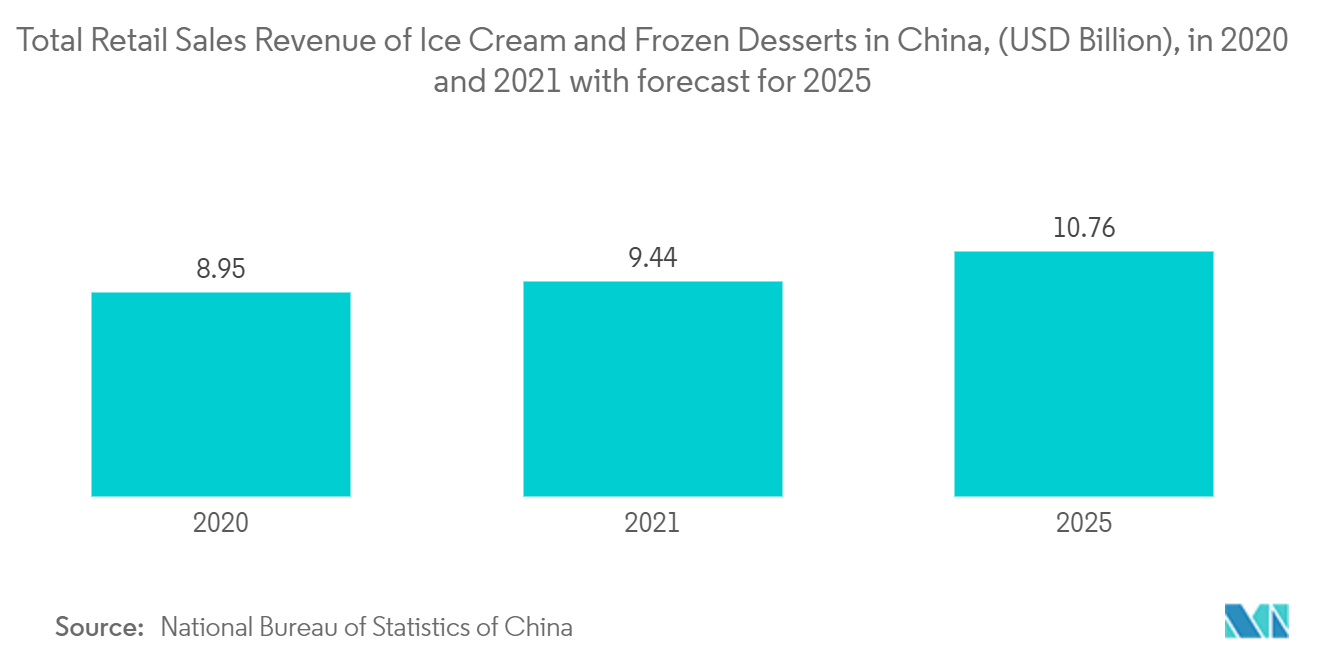
India to Grow at Significant Rate during Forecast Period
- In the past ten years, the export of final consumer food items from India, such as Ready to Eat (RTE), Ready to Cook (RTC), and Ready to Serve (RTS) products, has increased significantly. Food products falling under the RTE category have seen a Compound Annual Growth Rate (CAGR) of 12% over the past ten years. The share of RTE in Agricultural and Processed Food Products Export (APEDA) exports has increased from 2.1% to 5% over the same period, thanks to the Ministry of Commerce & Industry's emphasis on the value addition of products for export. (Source: Ministry of Commerce & Industry, India)
- Owing to the enticing fiscal incentives, supportive economic policies, and encouraging growth in the food retail sector, India's food ecosystem presents enormous investment prospects. The Government of India (GoI) is taking all necessary measures to increase investments in the food processing sector in India through the Ministry of Food Processing Industries (MoFPI). The government of India has allocated INR 4600 crores (USD 55.71 Billion) to the umbrella PMKSY plan through March 2026. The allotment will boost the demand for frozen food packaging.
- According to the Ministry of Food Processing Industries (MoFPI), the Indian food processing market will reach USD 470 billion by 2025. In the upcoming years, Tier-II and Tier-III cities may adopt the trend already seen in metropolitan areas by consuming more processed and frozen food, Thus, fueling the growth of frozen food packaging .
- India produces 7.96% of the world's fish, making it the third-largest producing country in the world with the total fish production for FY 20-21 at 14.73 MMT, compared to
- India is the third-largest fish-producing country in the world and accounts for 7.96 percent of global production. The total fish production during the financial year 2020-2021 was estimated at 13.69 million metric tons (MMT). Despite the industry's significant challenges in 2021-22, India still exported seafood worth Rs 57,586.48 crore (USD 7.76 billion). Compared to 2020-21, it saw a growth increase of 30%. The top 3 countries India prefers to export its marine products to are the USA, China, and Japan. 63% of exports were sent to these three nations, according to Invest India. These factors significantly contribute to the market growth rate during the forecast period.
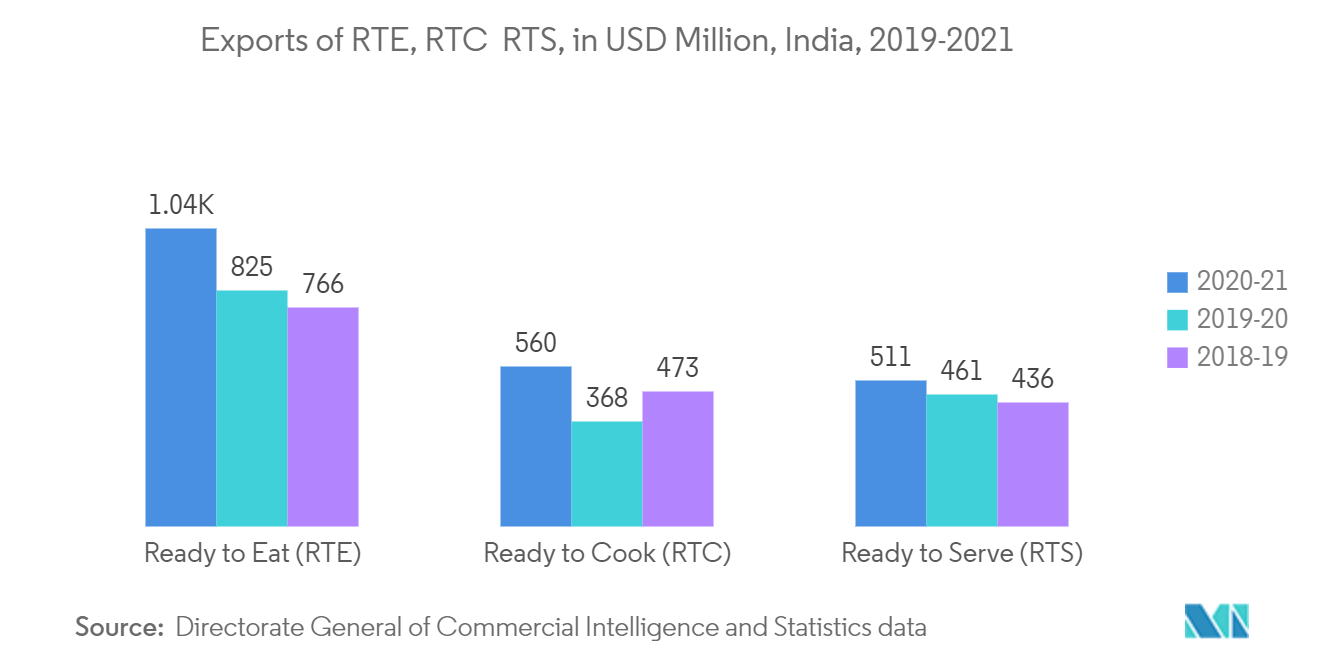
Competitive Landscape
The Asia Pacific Frozen Food packaging market is moderately fragmented and consists of several major players. The major players with a prominent market share are focusing on expanding their customer base across foreign countries.
March 2022 - Hong Kong 3D food printing firm Alt Farm is eyeing China and Australia as its first key target markets, revealing it hopes to launch a prototype plant-based A5 Wagyu Beef product in the next 12 to 18 months.
APAC Frozen Food Packaging Industry Leaders
Pactiv LLC
Amcor Ltd
Genpack LLC
Graham Packaging Company
Ball Corporation
- *Disclaimer: Major Players sorted in no particular order
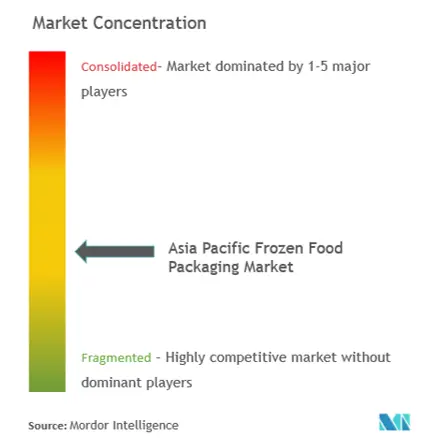
Recent Industry Developments
- March 2022- "FOODEX JAPAN 2022," the 47th edition of Japan's primary food and beverage exhibition, brought together 1,461 enterprises from 41 countries and regions with 1,787 booths intending to present new ideas to the food industry, which has achieved fresh innovation in the face of the COVID-19 epidemic. The exhibition, which featured current food trends such as a wide variety of value-added "frozen foods" and "substitute foods" according to the Sustainable Development Goals (SDGs), as well as recently popular "food-tech," held at Makuhari Messe in Chiba Prefecture.
- June 2022 - Walki, a food packaging producer, has launched a new range of recyclable frozen food packaging products, some of which can be recycled with paper and others with plastic.
APAC Frozen Food Packaging Market Report Scope
Frozen food packaging helps preserve food from when it is prepared to when the user will eat it. Frozen food packaging helps to maintain original color, flavor, and texture and generally more nutrients than foods preserved by other methods.
The market is segmented based on Primary material (Glass, Paper, Metal, Plastic), Type of food product (Readymade meals, Fruits and vegetables, Meat, Sea Food, Baked goods), and Type of packaging product (Bags, Boxes, Cans, Cartons, Trays, Wrappers), and Country. The market sizes and forecasts are in terms of value (USD million) for all the above segments.
| Glass |
| Paper |
| Metal |
| Plastic |
| Bags |
| Boxes |
| Cans |
| Cartons |
| Trays |
| Wrappers |
| Other Packaging |
| Readymade Meals |
| Fruits and Vegetables |
| Meat |
| Sea Food |
| Baked Goods |
| Other Food Product |
| China |
| Japan |
| India |
| Australia |
| South Korea |
| Rest of Asia-Pacific |
| Primary Material | Glass |
| Paper | |
| Metal | |
| Plastic | |
| Type of Packaging | Bags |
| Boxes | |
| Cans | |
| Cartons | |
| Trays | |
| Wrappers | |
| Other Packaging | |
| Type of Food Product | Readymade Meals |
| Fruits and Vegetables | |
| Meat | |
| Sea Food | |
| Baked Goods | |
| Other Food Product | |
| Geogrphy | China |
| Japan | |
| India | |
| Australia | |
| South Korea | |
| Rest of Asia-Pacific |
Key Questions Answered in the Report
What is the current APAC Frozen Food Packaging Market size?
The APAC Frozen Food Packaging Market is projected to register a CAGR of 5.34% during the forecast period (2025-2030)
Who are the key players in APAC Frozen Food Packaging Market?
Pactiv LLC, Amcor Ltd, Genpack LLC, Graham Packaging Company and Ball Corporation are the major companies operating in the APAC Frozen Food Packaging Market.
What years does this APAC Frozen Food Packaging Market cover?
The report covers the APAC Frozen Food Packaging Market historical market size for years: 2019, 2020, 2021, 2022, 2023 and 2024. The report also forecasts the APAC Frozen Food Packaging Market size for years: 2025, 2026, 2027, 2028, 2029 and 2030.
Page last updated on:
APAC Frozen Food Packaging Market Report
Statistics for the 2025 APAC Frozen Food Packaging market share, size and revenue growth rate, created by Mordor Intelligence™ Industry Reports. APAC Frozen Food Packaging analysis includes a market forecast outlook for 2025 to 2030 and historical overview. Get a sample of this industry analysis as a free report PDF download.
